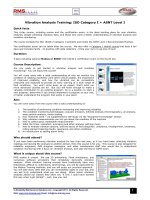DA4456 CMT curriculum updates level i
Bạn đang xem bản rút gọn của tài liệu. Xem và tải ngay bản đầy đủ của tài liệu tại đây (479.27 KB, 8 trang )
CURRICULUM UPDATES
2018
CMTA
2019
Section I: Theory and History of Technical Analysis
• Chapter 1: The Basic Principle of Technical Analysis - The Trend
• Chapter 1: The Basic Principle of Technical Analysis - The Trend
• Chapter 2: Dow Theory
• Chapter 2: Dow Theory
• Chapter 3: History and Construction of Charts
• Chapter 3: History and Construction of Charts
• Chapter 4: Trends - The Basics
• Chapter 5: Breakouts, Stops and Retracements
• Chapter 6: Moving Averages
• Chapter 7: Bar Chart Patterns
• Chapter 8: Short-Term Patterns
• Chapter 9: Confirmation
• Chapter 10: Candlestick Charting Essentials
• Chapter 11: Point and Figure Charting
• Chapter 12: An Introduction to the Wave Principle
• Chapter 13: The Anatomy of the Elliott Wave Trading
2018
CMTA
2019
Section II: Charts, Trends and Patterns
• Chapter 14: Overview
• Chapter 4: Trends - The Basics
• Chapter 15: Government
• Chapter 5: Breakouts, Stops and Retracements
• Chapter 16: Companies
• Chapter 6: Moving Averages
• Chapter 17: Hard Assets
• Chapter 7: Bar Chart Patterns
• Chapter 18: Indexes
• Chapter 8: Short-Term Patterns
• Chapter 19: Measuring Market Strength
• Chapter 9: Confirmation
• Chapter 20: What is the Efficient Market Hypothesis
• Chapter 10: Candlestick Charting Essentials
• Chapter 21: The EMH and the Market Model
• Chapter 11: Point-and-Figure Charting
• Chapter 22: The Forerunners to Behavioral Finance
• Chapter 23: Noise Traders and the Law of One Price
• Chapter 24: Noise Traders as Technical Traders
• Chapter 25: Option Pricing Basics
2018
CMTA
2019
Section III: Advanced Concepts in Charting and Trend Analysis
• Chapter 26: Objective Rules and Their Evaluation
• Chapter 12: Introduction to the Wave Principle
• Chapter 27: Basic Concepts and Calculations
• Chapter 13: The Anatomy of Elliott Wave Trading
• Chapter 28: Academic Approaches to Technical Analysis
• Chapter 14: Measuring Market Strength
• Chapter 29: Understanding Implied Volatility
• Chapter 15: Foundations of Cycle Theory (NEW)
• Chapter 30: About the VIX Index
• Chapter 16: Basics of Cycle Analysis (NEW)
2018
CMTA
2019
Section IV: Markets and Volatility
• Chapter 31: Being Right or Making Money
• Chapter 32: The Model Building Process
• Chapter 33: Seasonality and Calendar Patterns
• Chapter 34: Consensus and Commitment Indicators
• Chapter 35: Relative Strength as a Criterion for Investment Selection
• Chapter 17: Markets, Insturments, Data and the
Technical Analyst (NEW)
• Chapter 18: Equities (NEW)
• Chapter 19: Indexes (NEW)
• Chapter 20: Fixed Income/Bonds (NEW)
• Chapter 21: Futures (NEW)
• Chapter 22: Exchange-Traded Products (ETPs) (NEW)
• Chapter 23: Foreign Exchange (Currencies) (NEW)
• Chapter 24: Options (NEW)
• Chapter 25: Understanding Implied Volatility
• Chapter 26: About the VIX Index
2018
CMTA
2019
Section V: Behavioral Finance and Other Theories
of Market Dynamics
• Chapter 27: What is the Efficient Market Hypothesis
• Chapter 28: The EMH and the “Market Model”
• Chapter 29: The Forerunners to Behavioral Finance
• Chapter 30: Noise Traders and the Law of One Price
• Chapter 31: Noise Traders as Technical Traders
• Chapter 32: Academic Approaches to Technical Analysis
• Chapter 33: Market Sentiment and Technical Analysis (NEW)
• Chapter 34: Sentiment Measures from Market Data (NEW)
• Chapter 35: Sentiment Measures from External Data
2018
CMTA
2019
Section VI: Basic Statistics for the Technical Analyst
• Chapter 36: An Introduction to Descriptive Statistics (NEW)
• Chapter 37: Introduction to Probability (NEW)
2018
CMTA
2019
Section VII: Perspectives on Technical Trading Systems
• Chapter 38: Objective Rules and Their Evaluation
• Chapter 39: Being Right or Making Money
• Chapter 40: The Model Building Process
• Chapter 41: Relative Strength as a Criterion for Investment Selection









